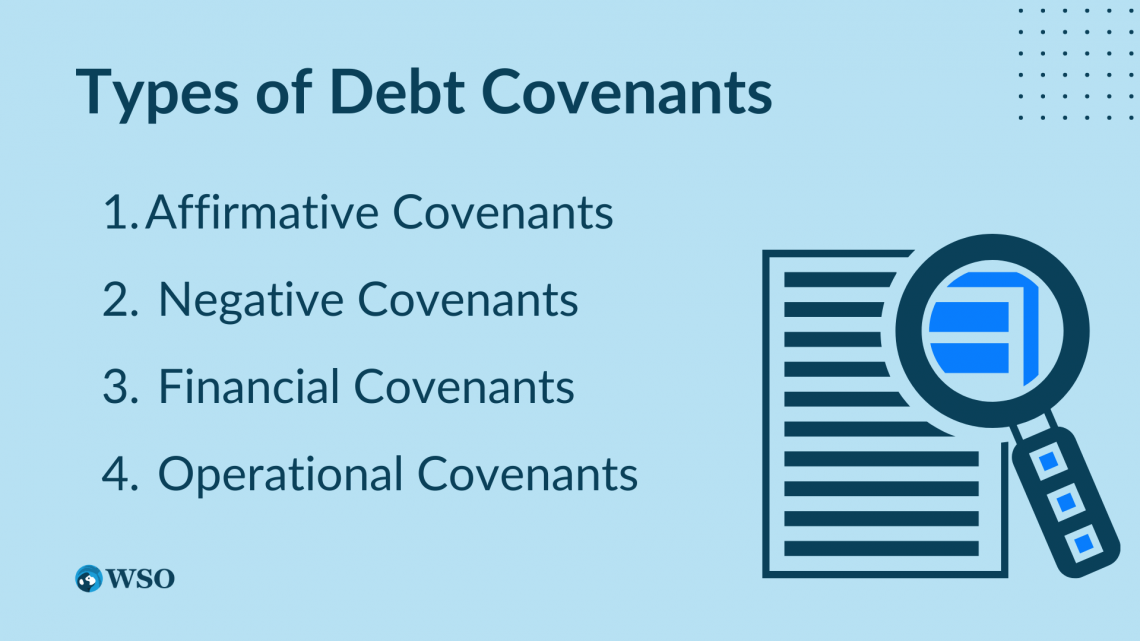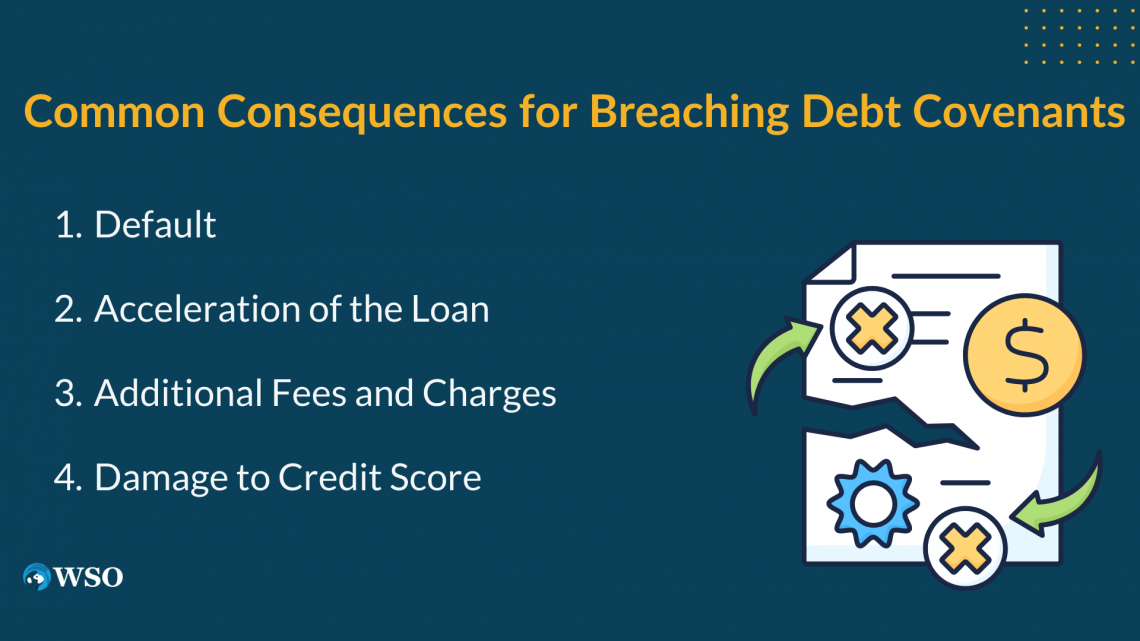Debt Covenants
Loan agreement clauses listing certain requirements the borrower must meet to maintain the loan
What are Debt Covenants?
There is a financial concept known as the "agency problem of debt" that arises from a conflict of interest between lenders & corporate borrowers.

When a company borrows money for a project, they are incentivized to pursue projects with higher returns, even if that means incurring more risk. In contrast, lenders are only entitled to the amount loaned and interest.
Debt covenants are an important clause in lending agreements. Lenders use this to protect their investment to ensure borrowers (companies) maintain a certain standing that makes them more likely to repay the loan.
These loan agreement terms are legally binding. They require the borrower to
- take certain actions,
- meet certain financial & operational requirements,
- or restrict their ability to take certain actions.
This is to mitigate the risk the lender takes on loaning an amount to a company. In addition, this can be used as a framework for the borrower to use the funds given to them.
These covenants also reduce the chances that the borrowers default on the loan because they did not maintain a strong financial position.
Note
Borrowers should understand the terms of these covenants to manage their obligations under the loan agreement and secure financing. Failure to comply can have serious consequences, like a loan acceleration or legal action.
Complying with these clauses can help borrowers maintain a rapport of confidence with their lenders, which can lead to better terms in the future. This can also help companies improve their credit rating.
We will explore different covenants on debt, their purpose, and how they work in this article.
We will also discuss the potential consequences of breaching covenants and provide tips for borrowers on how to manage their obligations under loan agreements.
By understanding the role of debt covenants, borrowers can better manage their financial obligations and achieve their business goals.
If you are interested in learning more about bankruptcy & debt concepts, consider taking the Wall Street Oasis’s Restructuring Course!
Types of Debt Covenants
There are different classifications for debt covenants. They are based on the nature and purpose of these covenants. The most common types are:

1) Affirmative Covenants
These covenants require the borrower to take specific actions or meet set requirements. This is to ensure the borrower can fulfill their loan agreement obligations.
The lender may ask the borrower to keep certain insurances or file regular financial reports.
2) Negative Covenants
These covenants restrict the actions of the borrower. They ensure the borrower doesn't engage in any activity that increases risk.
The lender may prohibit the borrower from taking on additional debt or transacting with related parties without the lender's approval.
3) Financial Covenants
These covenants require the borrower to maintain certain financial levels. They ensure the borrower maintains a certain financial standing to repay the loan.
The lender may ask the borrower to keep a certain amount of cash or leverage ratio.
4) Operational Covenants
These covenants require the borrower to uphold certain operating standards. This is to ensure the borrower is operating their business responsibly. For example, the lender may require the borrower to keep certain inventory levels or spend a certain amount on capital expenditures.
Each type of covenant serves a specific purpose. Depending on the risk assessment and the borrower's financial and operational position, lenders may include one or more of these covenants in loan agreements.
Note
Understanding the different types of covenants can help borrowers negotiate favorable terms and manage their obligations under the loan agreement effectively.
Affirmative Covenants
Affirmative covenants are loan agreement provisions requiring borrowers to take specific actions or meet certain requirements.

They ensure the borrower can maintain a certain level of financial and operational performance to repay their loan.
Some examples of affirmative covenants include:
1) Maintaining Insurance Coverage
Borrowers may be required to maintain insurance coverage to protect against potential risks and losses. The loan agreement may specify the type and amount of insurance required.
Lenders may tell the borrower to keep:
- Property Insurance
- Liability Insurance
- Worker's Compensation Insurance, or another type.
2) Filing Regular Financial Reports
The lender may require the borrower to submit regular financial reports to the lender. These reports provide the lender with insight into the borrower's financial position and performance.
The lender may request:
- Balance Sheets
- Income Statements
- Statements of Cash Flows
- Statements of Stockholders Equity, or any pro forma statements.
3) Complying with Regulatory Requirements
The lender may require the borrower to comply with certain regulatory requirements. These requirements help ensure that the borrower operates their business responsibly and competently.
The lender may require that the borrower complies with the following:
- environmental regulations
- labor laws, or
- industry-specific regulations
4) Maintaining Collateral
Borrowers may be required to maintain collateral to secure the loan. The loan agreement may specify the type and value of collateral required and how it should be maintained.
No matter if the borrower puts up
- Real Estate
- Equipment
- Inventory, or another aspect of their company as collateral, the firm must keep and maintain it.
Note
Lenders ensure borrowers can keep a strong financial & operational position by including affirmative covenants in their loan agreement.
Borrowers complying with these covenants can help build trust with the lender, potentially leading to better terms or lower interest rates. Conversely, failure to comply with affirmative covenants can have serious consequences, such as default and loan acceleration.
Negative Covenants
Negative covenants are provisions in loan agreements that restrict the borrower's actions. This is to decrease activity that may increase the risk of loan default.

Negative covenants can take various forms, such as limiting the borrower's ability to take on additional debt, pay dividends, or enter into transactions with related parties. Here are some examples:
1) Debt Restrictions
Lenders may limit how much more debt the borrower takes on in the future. This mitigates any extra financial risk the borrower takes to ensure they can repay the loan.
2) Dividend Restrictions
Lenders may have a clause restricting the borrower from paying dividends to shareholders without their approval. This increases the retained earnings the firm uses to pay off debt.
3) Transaction Restrictions
Lenders may restrict the transactions borrowers engage in. This can be activities like selling assets or lending money to another party. This prevents the borrower from doing transactions that benefit related parties at the lender's expense.
4) Collateral Restrictions
Borrowers may be restricted from disposing of or transferring collateral without the lender's prior approval. This keeps the lender's security safe and the borrower accountable for their financial obligation.
Negative covenants protect the lender's investment into the borrower and reduce the risk of default, but at the cost of limiting the borrower's flexibility and ability to run their business.
Financial Covenants
Financial covenants are loan agreement provisions requiring the borrower to maintain certain financial ratios or meet specific financial targets.

Lenders include them as a way to make sure borrowers keep a strong financial position and are capable of repaying the loan. Here are some financial covenant examples:
1) Debt-to-Equity Ratio
The lender may specify a ratio level in the clause for the borrower to maintain. For example, the lender may specify the borrower to keep a debt-to-equity ratio of 1:2.
For every dollar of debt, the firm must have 2 dollars of assets. This makes sure that the borrower keeps enough equity to pay their liabilities.
Debt-to-Equity Ratio = Total Debt / Total Equity
The borrower could be told to maintain a minimum ratio of earnings to interest expenses. For example, the lender may specify a ratio value of 1:3, with 3 dollars of earnings for every dollar of interest expense.
Interest Coverage Ratio = Earnings Before Interest & Taxes (EBIT) / Interest Expense
Note
This ratio ensures the borrower has sufficient earnings to cover their interest expenses.
3) Leverage Ratio
The borrower could be told to maintain a maximum level of leverage. For example, a lender may specify a value of 1:2, where the borrower needs to maintain their ratio so that their total debt cannot be more than 50% of their EBITDA.
This limits the risk that the borrower's risky financial practices do not impede their ability to repay the loan.
Leverage Ratio = Total Debt / EBITDA
4) Minimum Cash Balance
The borrower could be told to maintain a minimum level of cash reserves. For example, the lender may tell the borrower to maintain a minimum cash balance equal to three months of operating expenses. This acts as a safety net for unexpected events so the firm can continue to operate.
Lenders add financial covenants in their loans to mitigate the chances that they cannot repay the loan due to risky financial practices. As with other covenants, failing to meet these requirements can cause a loan default and repayment acceleration.
Operational Covenants
Operational covenants are provisions in loan agreements that require the borrower to maintain certain operating standards.

These covenants are designed to ensure that the borrower operates their business in a manner that supports their financial obligations under the loan agreement.
Some examples of operational covenants are:
1) Maintenance of Inventory
This requires the borrower to keep a certain level of inventory at all times. For example, a lender may ask the borrower to keep their inventory at 80% of average monthly sales.
This ensures the borrower has sufficient inventory to meet their customers' needs and generate revenue.
2) Capital Expenditures
This requires the borrower to make certain capital expenditures, such as investing in new equipment or upgrading their facilities. For example, a lender may ask the borrower to keep capital expenditures equal to 5% of annual gross revenue.
This ensures that the borrower maintains their business operations and can continue to generate revenue.
Note
By including operational covenants in loan agreements, lenders can ensure that borrowers maintain certain operating standards and operate their businesses in a manner that supports their financial obligations.
3) Limitations on Business Operations
This may place certain restrictions on the borrower's business operations. For example, the lender may tell the borrower they cannot enter new contracts or expand operations without the lender's approval.
This limits the risk the borrower may take on and ensures that they are operating their business in a manner that supports their financial obligations.
4) Reporting Requirements
This requires the borrower to provide the lender with regular financial reports and other operational information. It can include monthly financial statements and annual budgets.
This keeps the lender up-to-date on information regarding the borrower's financial and operational performance.
Note
Borrowers should remember there are serious consequences to not meeting these covenants and should carefully negotiate the terms of operational covenants to ensure they are achievable and aligned with their business objectives.
Breaching Debt Covenants
Breaching debt covenants can have serious consequences for borrowers. Lenders immediately consider the loan default if the borrower fails to comply with the covenant terms. Here are some common consequences for breaching a covenant:

1) Default
Default occurs when the borrower doesn't meet one of the loan covenants. The lender declares the loan default and demands immediate repayment of the loan. In addition, the lender can take legal action against the borrower to recover the outstanding loan balance owed.
2) Acceleration of the Loan
Occurs when the lender demands immediate repayment of the outstanding loan amount, including interest & fees. This can increase the financial pressure on the borrower because they have a short period to repay a lump sum.
3) Additional Fees and Charges
In addition to declaring a default and accelerating the loan, the lender may charge additional fees and penalties. For example, the lender may charge late fees, default interest rates, or legal fees associated with recovering the funds owed.
4) Damage to Credit Score
Loan default can negatively impact a borrower's credit score. As a result, the borrower may face more difficulty obtaining credit in the future and more covenants on any loan they take out.
It's crucial that borrowers carefully read their loan agreement and negotiate points of contention with the lender.
This can help ensure they can meet the requirements of their covenants. They should communicate with the lender as soon as they struggle to meet their covenant requirements.
Debt Covenants Summary
Debt covenants are an essential component of loan agreements and serve as a mechanism for lenders to manage their risk while providing borrowers with access to credit.

There are different types of loan agreement covenants, like:
- Affirmative Covenants
- Negative Covenants
- Financial Covenants
- Operational Covenants
Each covenant comes with its requirements and obligations that borrowers need to read the terms of the agreement to be wary of.
There are serious consequences that occur if a borrower does not comply with a covenant, like:
- Default,
- Acceleration of loan repayment,
- Additional fees and charges,
- and damage to credit scores.
Here are some steps borrowers should take to manage their loan agreement covenants:

1) Understand the loan terms.
Read the loan terms carefully to understand the requirements and obligations placed upon them from the covenant.
2) Create a plan to meet the covenants.
Make a plan to meet the covenant requirements. This includes having the resources and systems to comply with the covenant successfully.
3) Communicate with the lender.
Quickly communicate with the lender if you struggle with the covenants in place. They may be willing to modify the loan agreement or provide additional support to help you meet your obligations.
By following these tips, borrowers can effectively manage their obligations under loan agreements with debt covenants and avoid the serious consequences of breaching them.
You can learn more about debt concepts with the Wall Street Oasis’s Restructuring Course!
Debt Covenants FAQs

Debt covenants are loan agreement clauses listing certain requirements the borrower must meet to maintain the loan. They are a tool for lenders to manage risk because they ensure the borrower has the finances & operating ability to repay the loan.
Debt covenants are a risk mitigation tool for lenders and a framework for managing finances for borrowers.
Breaching a debt covenant can have serious consequences, including default, acceleration of the loan, additional fees and charges, and damage to credit scores. The lender may take legal action against the borrower if the breach is significant.
In some cases, however, any modifications must be agreed upon by both the lender and the borrower and typically involve negotiations and additional fees or charges.
They should carefully read the terms of a loan agreement and develop a plan to meet all the covenant requirements
Yes, there are alternative financing structures that do not rely on traditional debt covenants. For example, revenue-based financing and equity financing may provide alternatives for borrowers unable or unwilling to meet the requirements of traditional covenants.









or Want to Sign up with your social account?